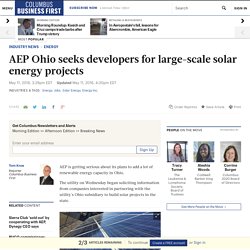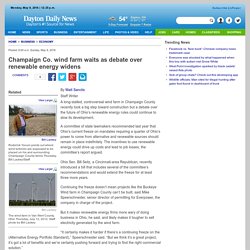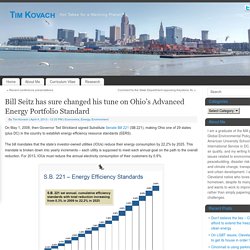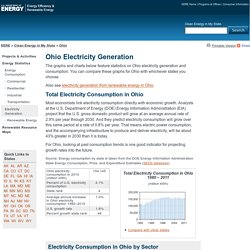

OH RPS report FINAL 5.11.16. AEP Ohio seeks interested developers in 400 megawatt solar energy project, especially for Appalachian Ohio - Columbus - Columbus Business First. A solar array at Sycamore Township Fire Department's facilities in Cincinnati.

Tom Knox AEP is getting serious about its plans to add a lot of renewable energy capacity in Ohio. The utility on Wednesday began soliciting information from companies interested in partnering with the utility's Ohio subsidiary to build solar projects in the state. AEP committed to building 900 megawatts of wind and solar powered projects in the state as part of a December agreement with the Sierra Club. The environmental group dropped its once-heated opposition to AEP's income-guarantee plan in large part because of the provision. The Columbus company's Gahanna subsidiary, AEP Ohio, said it would carve out 400 megawatts of solar-powered projects, with preference for the Appalachian part of the state that today is reliant on coal, and 500 megawatts of wind projects.
The Sierra Club's Beyond Coal campaign aims to phase out coal and replace it with renewable energy sources. Untitled. Champaign County wind farm waits as debate widens on energy. A long-stalled, controversial wind farm in Champaign County recently took a big step toward construction but a debate over the future of Ohio’s renewable energy rules could continue to slow its development.

A committee of state lawmakers recommended last year that Ohio’s current freeze on mandates requiring a quarter of Ohio’s power to come from alternative and renewable sources should remain in place indefinitely. The incentives to use renewable energy could drive up costs and lead to job losses, the committee’s report argued. Ohio Sen. Bill Seitz, a Cincinnati-area Republican, recently introduced a bill that includes several of the committee’s recommendations and would extend the freeze for at least three more years. Continuing the freeze doesn’t mean projects like the Buckeye Wind farm in Champaign County can’t be built, said Mike Speerschneider, senior director of permitting for Everpower, the company in charge of the project. Buckeye Wind farm challenges Finding a middle ground “Gov. Uea94115. Champaign County wind farm waits as debate widens on energy. SB 310 Archives - Northeast Ohio Sierra Club Group.
President Obama delivers his speech announcing the final Clean Power Plan on Monday, August 3 (courtesy of Susan Walsh/Associated Press).

Last Monday, President Obama stood at the podium in the East Room of the White House to announce “the single most important step America has ever taken in the fight against global climate change” – the final Clean Power Plan (CPP). As the President noted in his remarks, this final rule amounts to “the first-ever nationwide standards to end the limitless dumping of carbon pollution from power plants” into our atmosphere. The EPA projects that, if fully implemented, carbon emissions from US power plants should be 32% lower in 2030 than in 2005. Here in Ohio, the rule was met by a mixture of excitement from those of us who want the country to take action on climate change and outrage from those who oppose such steps. Changes to the final Clean Power Plan that affect Ohio. Drops in Ohio clean energy investment could hurt jobs, growth. A drop in investments in Ohio’s clean energy industry could cost the state jobs, say industry experts.

Matters could be made worse by continuing uncertainty about the future of Ohio’s renewable energy and energy efficiency standards. Last week the Pew Charitable Trusts released a report documenting the huge growth in investments in Ohio’s clean energy industry in the years following adoption of those standards in 2008. That same report also shows a huge drop after state lawmakers began debating changes to those standards in 2013.
The study’s authors expect investment levels will stay low through at least 2017. Bill Seitz has changed his tune on Ohio's Advanced Energy Standard. On May 1, 2008, then-Governor Ted Strickland signed Substitute Senate Bill 221 (SB 221), making Ohio one of 29 states (plus DC) in the country to establish energy efficiency resource standards (EERS).

The bill mandates that the state’s investor-owned utilities (IOUs) reduce their energy consumption by 22.2% by 2025. This mandate is broken down into yearly increments – each utility is supposed to meet each annual goal on the path to the overall reduction. For 2013, IOUs must reduce the annual electricity consumption of their customers by 0.9%. Ohio project takes advantage of untapped hydro potential. A series of six small hydroelectric projects along the Muskingum River in southeastern Ohio point to hydropower's potential as a robust, if underused, energy source for the state, supporters say.

FFP New Hydro LLC, a developer of hydroelectric ventures on existing dams, and its partner group AECOM Capital obtained their last Federal Energy Regulatory Commission (FERC) license in March to convert a half-dozen Muskingum dams to hydropower. The generation facilities will be added to existing lock and dam structures owned and operated by the Ohio Department of Natural Resources. The projects, rated at 23 megawatts, will produce enough electricity to power 11,500 homes in Muskingum and Morgan counties, for a total cost of $118 million.
Each site will provide anywhere from three to five megawatts, eliminating the need for coal, natural gas or other non-renewable energy generation, said proponents. With licensing secure, plan partners are now moving onto engineering analysis and design. Report: Efficiency could provide big benefits to low-income renters. Low-income households spend up to three times as much of their income on energy costs as higher-income households do, and would benefit significantly from efficiency upgrades, according to a new report.

Since their total income is lower, it’s not surprising that such households would see a higher proportion of it spent on energy. But these households are often paying more than they should be for energy because they are more likely to live in inefficient buildings, often where they don’t have control over heating and cooling or the power to make efficiency upgrades. On average, the report found, low-income households spend 7.2 percent of their income on energy while higher-income households spend only 2.3 percent. But the study found that increased efficiency measures could close this energy burden gap by about one-third. Soros Says China's Debt-Fueled Growth Echoes U.S. in 2007-08. Billionaire investor George Soros said China’s debt-fueled economy resembles the U.S. in 2007-08, before credit markets seized up and spurred a global recession.

China’s March credit-growth figures should be viewed as a warning sign, Soros said at an Asia Society event in New York on Wednesday. The broadest measure of new credit in the world’s second-biggest economy was 2.34 trillion yuan ($362 billion) last month, far exceeding the median forecast of 1.4 trillion yuan in a Bloomberg survey and signaling the government is prioritizing growth over reining in debt. Report: State renewable energy standards succeeding, at little cost. ©2016 E&E Publishing, LLC Republished with permission By Rod Kuckro States with renewable portfolio standards have been highly successful at meeting their targets, with a handful of states setting higher targets within the past year while at the same time average compliance costs added an average of 1.3 percent to customer bills.

Those are among the findings of an annual report from Lawrence Berkeley National Laboratory that looks at the mandatory renewables policies in 29 states and the District of Columbia. Report: State renewable energy standards succeeding, at little cost. Clean Energy in My State: Ohio Electricity Generation. The graphs and charts below feature statistics on Ohio electricity generation and consumption.

You can compare these graphs for Ohio with whichever states you choose. Also see electricity generation from renewable energy in Ohio. Total Electricity Consumption in Ohio Most economists link electricity consumption directly with economic growth. Analysts at the U.S. For Ohio, looking at past consumption trends is one good indicator for projecting growth rates into the future. Clean Energy in My State: Electricity Generation from Renewable Energy in Ohio. The graphs and charts below feature electricity production statistics for the following renewable energy resources in Ohio: Per capita statistics allow comparison of these data with those from other states of different sizes.
The sources for these data include the following: U.S.
Former NRG CEO Davide Crane: The yieldco business model is 'completely broken' (Video) - Houston Business Journal. April 5 -- Former NRG Energy CEO David Crane discusses the clean energy business. He… more speaks on "Bloomberg Markets. " David Crane, former president and CEO of NRG Energy Inc., told Bloomberg he thinks the… more Bloomberg NRG Energy Inc. (NYSE: NRG) was an early adopter of a business model that the company’s former CEO now says needs to be reworked. David Crane, who left the Houston- and New Jersey-based company in December, recently spoke to Bloomberg about renewable energy, private equity and the “yieldco” business model.
Similar to a master limited partnership, a yieldco is a publicly traded corporation that “provides stable and growing distributions for investors from operating assets that generate a predictable stream of cash flow,” according to EY. NRG Yield Inc. went public in 2013. Deny coal plant owner's request. First Energy rate increase will negatively impact citizens: Letter to the Editor.
Deny coal plant owner's request. Deny coal plant owner's request.
UPDATED: FERC Action Awaited Following PUCO OK on PPAs. By Ted Caddell and Rich Heidorn Jr. Having won Ohio regulators’ approval of their controversial power purchase agreements, American Electric Power and FirstEnergy now are hoping the PPAs will pass muster with FERC. The Public Utilities Commission of Ohio on Thursday unanimously approved modified versions of two PPAs, which the companies said are crucial to keeping some of their underperforming plants running in the state (14-1297-EL-SSO and 14-1693-EL-RDR). On Monday, AEP and FirstEnergy formally notified FERC of the approvals. Competing merchant generators have asked FERC to revoke the waivers it granted AEP and FirstEnergy regarding affiliate power sales to ensure a Section 205 review of the above-market deals (EL16-33, EL16-34).
(See PJM Joins EPSA’s Call for FERC Review of Ohio PPAs.) The companies have asked FERC to rule before PJM’s next Base Residual Auction, which begins May 11. UPDATED: FERC Action Awaited Following PUCO OK on PPAs. Michigan utility looks to meet renewable energy needs of large customers. JACKSON — Michigan’s second-largest electric utility says it is developing a program to meet the needs of large energy users who want more of their electricity to come from renewable sources. Consumers Energy’s business customers are driving the push for alternative energy even more than state policy mandates, said Nancy Popa, executive director of renewable energy for the Jackson-based utility. “Historically, adding renewable energy to our portfolio was largely driven by policy because of cost,” Popa said.
“It’s just kind of interesting to me that we’re looking at new renewable energy and it’s not being driven by policy or cost — it’s being driven by customers wanting more renewable energy. It’s really a new paradigm.” Consumers Energy still needs to determine the details about its new program. Ohio Adopts 'No-Fault Capitalism' for AEP, First Energy. Years ago, a friend said he viewed electric utilities as an example of “no-fault capitalism,” because state regulators always bail the companies out when they make bad business decisions. That was before the mid-1990s restructuring that brought competition to many markets that were previously monopolies. Among them was Ohio’s utility system, an entrenched monopoly environment that only reluctantly got dragged into the world of real capitalism.
Now, the Buckeye State’s two dominant utilities – AEP and First Energy – have persuaded the local regulator, the Public Utilities Commission of Ohio, to embrace no-fault capitalism. Michigan utility looks to meet renewable energy needs of large customers. Energy forecasters consistently underestimate wind and solar. A critic explains why that’s a problem. S.E.C. Orders Exxon Mobil Shareholder Vote on Climate Data. Energy Archives - Page 3 of 3 - Tim Kovach. On May 1, 2008, then-Governor Ted Strickland signed Substitute Senate Bill 221 (SB 221), making Ohio one of 29 states (plus DC) in the country to establish energy efficiency resource standards (EERS). This Small Town Generated $2 Million From Selling RECs, Now They Have to Decide What to Do With the Money. This Small Town Generated $2 Million From Selling RECs, Now They Have to Decide What to Do With the Money. 14 Statewide News Community Solar in Ohio.
The Oberlin Project. Despite the demise of federal climate change legislation, cities across the nation continue efforts started under the 2009 federal stimulus act to revitalize their communities and make them sustainable. One of the most inspiring examples is right here in Ohio. The Oberlin Project is a collaboration among the City of Oberlin, Oberlin College, the city’s municipal electric utility, as well as community and business stakeholders, to make Oberlin, Ohio the greenest little city in the U.S. and a national model for sustainable economic development.
In the process, the project hopes to revitalize the ailing local economy, equip local residents with the green skills needed to do the work and create an educational laboratory for younger generations. Environmental Policies Are Good For Business And Innovation, Study Says. Environmental policies are often vilified as economical agents of destruction. From the Clean Power Plan, to methane rules, to the Paris Agreement, every time a new environmental policy is proposed detractors argue that new rules drive costs up, kill jobs, and hamper trade. Wind and solar provided all new U.S. electric capacity in January. Ohio Politicians on "Energy Mandates Study Committee" Took $830,000 From Dirty Energy Companies. Ohio voters favor green energy, efficiency and political candidates who do the same, poll finds. The Hatfield's Ferry power plant in Pennsylvania has the capacity to generate more than 1,700 megawatts. The power plant's three boilers are fueled with coal.
Questions over standards as solar capacity outpaces utility demand. More than a decade ago, Pennsylvania lawmakers set out requirements for electric utilities to purchase increasing amounts of electricity from alternative and renewable energy sources for 12 years. Climate Positive Community, Sustainable Economic Development, Local Agriculture, Green Arts District - The Oberlin Project. Ohio clean energy standards benefits report. US Solar Market Sets New Record, Installing 7.3GW of Solar PV in 2015. In yet another record-breaking year, the solar industry in the United States installed 7,286 megawatts of solar PV in 2015. GTM Research and the Solar Energy Industries Association announced the historic figures today ahead of the March 9 release of the U.S. Why the Supreme Court stay on the Clean Power Plan 'means nothing' for efficiency. Why community solar is becoming big business. Our Power Campaign » Net Metering Toolkit.
eA-lets-talk-climate. Ohio Power Companies, Consumers Spar Over Who Pays for Spare Electricity. Forbes Welcome. 2013 11 22 lb energy deeps nov 13 final. Press Release: New Analysis Shows Big Savings for Ohio with Energy Efficiency. Thick-Skinned: The Resiliency of Pro-Renewable Policies in the States.
Most Polluted Cities - State of the Air 2014. Home - American Lung Association. Ohio - American Lung Association. Jaw-Dropping News in the Solar vs. Fossil Fuels Debate. 50 States. INVESTIGATIONS Archives - Checks and Balances Project. Energy Mandates Committee Makes Unpopular and Unsupported Recommendations, Gets Denounced by Many Across Ohio. Renewable Power Education Programs. Infographic: Green Job Types and How Much They Pay - Pure Energies USA. Jobs - Fossil Fuels Vs. Renewables - Citizens' Climate Lobby. Midwest Energy News. Jobs - Fossil Fuels Vs. Renewables - Citizens' Climate Lobby. PolluterWatch. Energy and Policy Institute Attacks on Renewable Energy Policies in 2015 Final. ‘Giveaways’ fill final report on Ohio clean energy standards. Ohio Solar.
About RENEW - Retrofits for Energy Efficiency Works (RENEW) Clean Energy Standard Freeze Suffocating Investment in Ohio. Promoting environmentally and economically sustainable energy policies and practices in Ohio. Ripple Effect. The Growing Link Between Energy Efficiency and Economic Development. One California Community's Power Switch. One California Community's Power Switch. Untitled. Clean Energy & Energy Efficiency Reduce Pollution. Ohio-Energy-Productivity-Issue-Brief.pdf. The Wind and Sun Are Bringing the Shine Back to Buffalo. Dynegy lobbying against AEP’s power purchase agreement plan - Columbus - Columbus Business First. Dynegy lobbying against AEP’s power purchase agreement plan - Columbus - Columbus Business First.
Saving money on energy, 20 percent by 2020, means having more for everything else. Dynegy lobbying against AEP’s power purchase agreement plan - Columbus - Columbus Business First. Renewable Energy in Nebraska. Prairie State seems to want the EPA to reward it for failure - Crain's Cleveland Business. Ohio Wraps Up its SB 310 "Energy Mandates" Committee, But the Facts Don't Lie: Efficiency and Renewables are a Win-Win for the State.
Letters to the editor: Embrace renewable energy, a good deal with Iran and justices overreach — July 17 - VOP. FirstEnergy & Ohio Supreme Court. Obama May Win by Losing in Quirk of Supreme Court EPA Review. It is not public's responsibility to bail out FirstEnergy: Letter to the Editor. FirstEnergy should win its electric security plan, to save reliable power plants and jobs: Thomas J. Coyne Jr. FirstEnergy closes 104-year-old coal power plant, electric rates to rise (interactive map) PUCO needs to reject FirstEnergy's plan to keep operating expensive plants: Letter to the Editor.